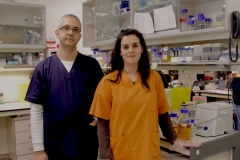
2015/06/09
The barrier preventing fatal disease transmission from deer to humans is identified
- Research by the University of California in co-operation with the Ikerbasque researcher Joaquin Castilla's team at CIC bioGUNE, gains deeper knowledge in resistance and propagation mechanisms of certain prions.
- The research, published by the Journal of Clinical Investigation, opens the door to the development of new therapeutic approaches to diseases caused by these infectious agents.
- Chronic Wasting, a prion disease found in deer, has been known for over 50 years but the reasons why it does not affect humans were unknown.
(Bilbao, June 2015).- A research project led by the University of California with the co-operation of the Basque Center for Cooperative Research in Biosciences CIC bioGUNE has identified amino acids acting as a structural barrier to prevent Chronic Wasting transmission to humans. This Chronic Wasting Disease (CWD) is a fatal prion disease which afects deer and elks.
This research, recently published by the Investigation, is highly relevant as it helps understanding human resistance and transmission mechanisms against certain prions and facilitates the use of this information to develop new therapeutic approaches for other diseases caused by these infectious agents and even illnesses whose origin has yet to be fully explained but which share similarities such as Alzheimer's and Parkinson's disease or Amyotrophic Lateral Sclerosis (ALS).
Prions are infectious agents transmitted among living beings of the same species but they are also known for being able to infect other species, for example in the case of Bovine Spongiform Encephalopathy (BSE) in humans also known as 'mad cow disease'.
Nevertheless, there are other diseases like Chronic Wasting, a prion disease found in deer which has been known for over 50 years but has never afected humans.
The research, led by Doctor Christina J. Sigurdson at the University of California with the notable participation of the Ikerbasque researcher Joaquín Castilla at CIC bioGUNE jointly with Natalia Fernández-Borges, has led to the identification of the amino acids which make up a structural barrier preventing Chronic Cachexia transmission to humans.
The research consisted of replacing four amino acids in the human protein sequence in transgenic mice inoculated with deer prions. As a result, mice showing a manipulated protein were highly susceptible to infection.
"Research conclusions contribute to reveal some molecular requirements for prion transmission among different species", stated the coordinator of the Infectious Diseases Program at CIC bioGUNE, Joaquín Castilla.
The purpose of this work is to "discover why deer prions don't seem to be infectious for humans and unveil the molecular resistance mechanism in humans against deer cachexia", he added.
In recent years, this research field has gained more relevance and attracted buzzing activity as it includes prion-like diseases such as Alzheimer's and Parkinson's disease or ALS, which share similar propagation mechanisms.
"Knowing how prions propagate will have a direct impact on the knowledge of other diseases with greater incidence in the population" explained Castilla.
This research opens the door to new research lines because as soon as the mechanisms making certain species resistant to certain prions are known in detail, this information will generate new therapeutic approaches to block any type of prion infection and find a cure for diseases which are currently fatal and for which there is no available therapy.
- Supplementary information Prions
Joaquín Castilla has wide research experience in the field of prion diseases and has carried out notable research work linked to both ‘mad cow disease' and another prion illness which afflicts rabbits.
"Prions are the pathogens responsible for TSEs, which are also known as prion diseases. TSEs belong to a group of fatal neurodegenerative diseases that affect both humans and animals and for which there is no available therapy. These diseases may be hereditary, sporadic (supposedly spontaneous) or infectious in nature", explains Prof. Castilla.
The bovine transmissible spongiform encephalopathy epidemic in Europe, better known as "mad-cow disease", resulted in an increase in the number of research teams dealing with this kind of infectious agent. As a result, the last decade has witnessed major progress in our understanding of prions. However, there is still much to be discovered.
According to Castilla "prions are probably one of the most intriguing pathogens in nature, as their theoretical single protein composition and the presence of clearly different strains give them an unprecedented scientific value". Their propagation mechanism, which resembles that of Alzheimer or Parkinson diseases, among others, makes them unique pathogens.
About CIC bioGUNE
The Centre for Cooperative Research in Biosciences CIC bioGUNE, with headquarters in the Bizkaia Science and Technology Park, is a biomedical research organisation that conducts innovative research on the interface between structural, molecular and cell biology, focusing especially on the study of the molecular bases of disease, to be used in the development of new diagnostic methods and advanced therapies.
Reference:
Human prion protein sequence elements impede cross-species chronic wasting disease transmission
Timothy D. Kurt1, Lin Jiang2, Natalia Fernández-Borges3, Cyrus Bett1, Jun Liu1, Tom Yang1, Terry R. Spraker4, Joaquín Castilla3,5, David Eisenberg2, Qingzhong Kong6, and Christina J. Sigurdson1,7
See a large version of the first picture





